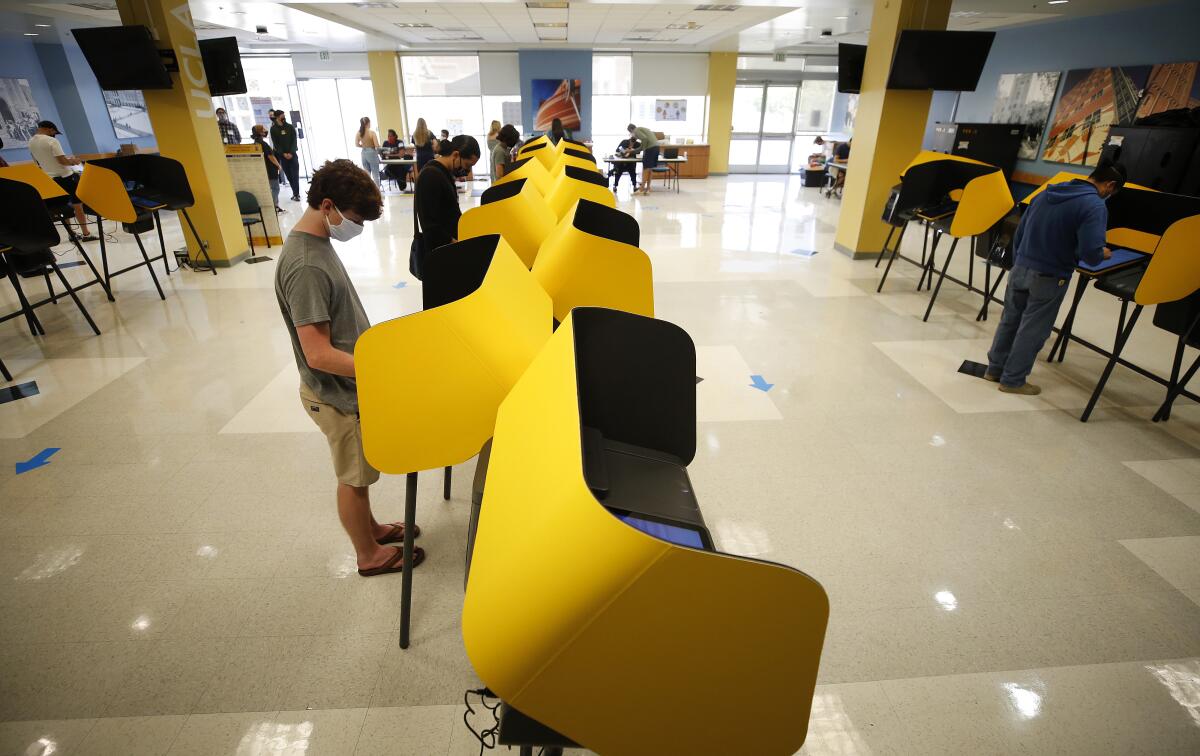Op-Ed: Gen Z students seem to dislike both political parties. What will make them change their minds?

- Share via
The perception of a liberal, monolithic student body on college campuses needs to change. Critics of higher education often rail against the left-leaning prejudices of students, but the fact of the matter is that the political hearts and minds of undergraduates are not overwhelmingly aligned with either major political party.
While students largely reject the Republican Party, they are not heavily supportive of the Democrats either. Instead, most students are independents and untethered to either major party, suggesting that a huge opportunity exists for whichever party is wise enough to pay attention to the growing number of Gen Zers in college today.
A new survey of more than 1,500 college students nationwide conducted for us by College Pulse reveals a deep disconnect between students and both major parties. Most college students do not see themselves as Democrats or Republicans. Some 34% of students surveyed identify as strong or weak Democrats, and 11% claim to be strong or weak Republicans, leaving the majority, 54%, identifying as independents — those who say they still lean toward a party, or something else entirely. There are notably more Democrats at private schools (41%) than at public institutions (31%), but Democrats are far from dominant on most campuses today.
Moreover, the collegiate figures show that students are no more Democratic than the nation as a whole. Nationally, about 33% of registered voters identify as Democrats, about 3 in 10 (29%) identify as Republicans, and the remainder (34%) are independents. Although college students are less likely to be Republican and more likely to be centrist, they are not necessarily more leftist than the rest of the nation.
Some fields of study do have higher proportions of Democrats, because they may draw students who are more focused on politics and activism than others. But once again, the data reveal far more balance than what many believe. Just 38% of those who major in the humanities, arts, and various area studies — the departments that tend to be the most progressive and activist-oriented — are Democrats, while 9% are Republican. The majority of students in these fields are somewhere in the middle. Students in the performing and visual arts lean more Democratic, but nearly 40% don’t identify with either major party.
Moving beyond the humanities, 29% of students majoring in business or an allied field such as accounting or management identify as Democrats, 17% as Republicans, and the majority (52%) are in the middle. Engineers and computer scientists look very similar: 29% are Democrats, 13% are Republicans, and the majority (58%) are centrists. As for those studying economics and the social sciences, just 27% are Democrats and 15% are Republicans. Again, most (58%) students in these fields are in the middle. Across the campus population, students are far less captive to any party than many observers contend.
The Republican Party has clearly alienated many college students. Still, most of these students have not migrated to the Democratic Party. In fact, most students dislike both parties: Only 10% think that the Republican Party is moving in the right direction, and just 18% say that’s true of the Democrats.
College and university students appear generally pessimistic about both parties. Some 60% said they are very or somewhat pessimistic about the future of the Republican Party; 41% felt that way about the Democratic Party. The 2020 American National Election Study found that 47% of Gen Zers said there was no party that represented their views reasonably well and they were less likely to consider traditional politics as part of their identity. Our research and polling show that this generation wants a voice but neither party has done enough to connect with them.
As Gen Zers mature, they will become a far larger part of the electorate and thus critically important for the parties as the Silent Generation (people over 80) and the boomers die or age out of the political world. Moderate pragmatism and greater efforts at connecting with them now might be a better strategy with these voters than rigid ideologies, which they are already rejecting.
Jeremi Suri is a professor of public affairs and history at the University of Texas at Austin. Samuel J. Abrams is a professor of politics at Sarah Lawrence College and a nonresident senior fellow at the American Enterprise Institute.
More to Read
A cure for the common opinion
Get thought-provoking perspectives with our weekly newsletter.
You may occasionally receive promotional content from the Los Angeles Times.










